LP12MF Listening Test: Linn Ekos 2 Tonearm and Kore Subchassis
In the latest edition of the LP12 Modification Frenzy, I install a very fancy tonearm and a moderately fancy subchassis, both made by Linn. You can read about the installation process for both, and check out my listening methodology. Full listening impressions on the Ekos and Kore are below; digestible, numerical summaries of all my listening tests are here.
tl;dr
The previous round was a disaster. Whatever the reason, swapping out an Adikt MM cartridge ($700USD MSRP) and installing a considerably fancier and more expensive Dynavector XX-2 mkII MC cartridge ($2000USD MSRP) — and running it through the same Dynavector phono sage, which you’d think would favor the Dynavector cartridge — made my system sound awful. Was it a cartridge/arm mismatch? Was it poor alignment? Both seem likely in retrospect, and my other hypotheses still hold some weight.
But hope persisted: if I nailed the alignment and put the XX-2 mkII on a very fancy tonearm, the Linn Ekos 2, the combination should sound better than the much cheaper Nima/Adikt combination.
Well, it didn’t.
Although it sounded way better than the XX-2/Nima/Mober configuration, the XX-2/Ekos 2/Kore still sounded considerably worse than the Adikt/Nima/Mober combination. According to my way of recording scores, the setup this round sounded 9.6% better than Round 6 (XX-2/Nima/Mober), but 5.8% worse than Round 5 (Adikt/Nima/Mober).
It’s not that this configuration sounded bad. In general, I really enjoyed its smooth and bass-heavy presentation. Although it lost a bit of treble definition by weighting itself so heavily to the bottom end, in most cases I was happy with the compromise. On my most rock-n’-roll tracks (“While My Guitar Gently Weeps,” “Panda,” “Halleluwah”) this setup sounded really, really good. But on more delicate tracks, I definitely missed some detail, springiness, and natural, lifelike presentation. Only two of the worst-sounding test tracks (The Beach Boys and Mingus) sounded better here than in Round 5. On amazing-sounding recordings like Joy Division’s “Atmosphere,” I was left pretty disappointed.
Why did this expensive setup not sound better than the cheaper one it replaced?
Let’s explore some hypotheses. (Update: Most of the mystery here was cleared up by removing the Kore and installing the Mober subchassis. This is all discussed here.)
1. Maybe there’s something wrong with the cartridge
After obsessively checking alignment, I’m sure it’s spot on. (Unless there’s something wrong with the Best Tractor, which I doubt.)
But this cartridge came to me used, and although the (trustworthy) person who sold it to me told me it only has 50 hours of usage, maybe he was wrong, and maybe it’s worn out.
To test this hypothesis, I finally bought the Hi-Fi News Test LP to see if it had a tracking problem. The results were a little inconclusive. At the maximum tracking weight and with the anti-skate set to the most tracking-conducive setting, it tracked the first “stress test” track (+12dB) pretty well, and got through the second (+14dB) with some distortion, then gave the third an honest shot before failing (+16dB). It totally failed on the fourth (+18dB). You can see it doing its thing in the video below.
This isn’t a great performance, and it reinforces my impressions that the XX-2 is not tracking very well. Most noticeably, it sometimes comes in too hot off the run-in grooves and skips over the first couple seconds of a side. A few times, it’s missed the fixed groove at the end of a side and spun straight onto the label.
But I don’t think it necessarily indicates a fatal flaw with the cartridge. Various forums suggests these tracks are unrealistically harsh and don’t necessarily reflect real-world tracking. And as I understand it, MC carts often simply don’t track as well as MM carts. It’s the first MC cart I’ve ever tried, though, so I’m not really sure.
For comparison, though, my comparatively cheapo Rega P3/Elys II setup makes it through all four tracks. You can watch it doing its thing (totally out of focus) below.
So the jury is out on this one. I’m not hearing much sibilance, or obvious signs of mistracking, so I sort of doubt this is the main issue. I think swapping in other cartridges (the Troika and the venerable Adikt) should help sort this one out.
2. Maybe the Kore subchassis is to blame — possibly because it’s not flat/true (which it definitely isn’t)
I’m more intrigued by this line of thought, and it’s also easy to test.
When I was setting up the Ekos/Kore combination, I noticed that when the back of the armboard was flat against the plinth, the front of the arm board was slightly off. If I got the front flat, the back would be off. When I sighted down the armboard, I could see there was a slight bend about a quarter of the length from the front. I’ve done my best to photograph it here, adding a thin yellow line to show the straight line from which it deviates at that one-quarter mark.
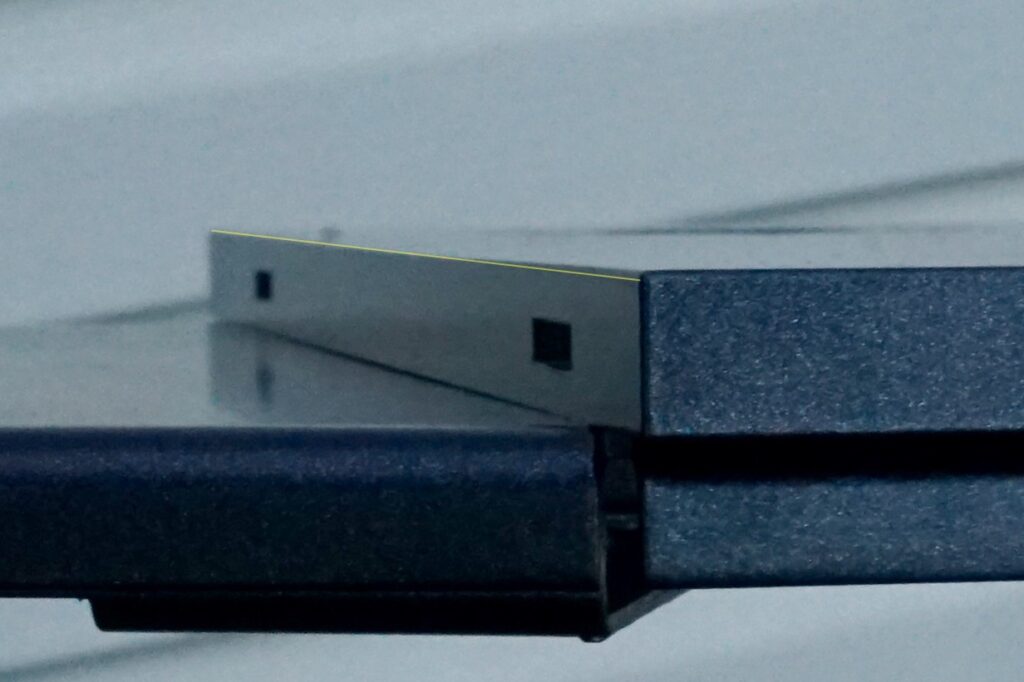
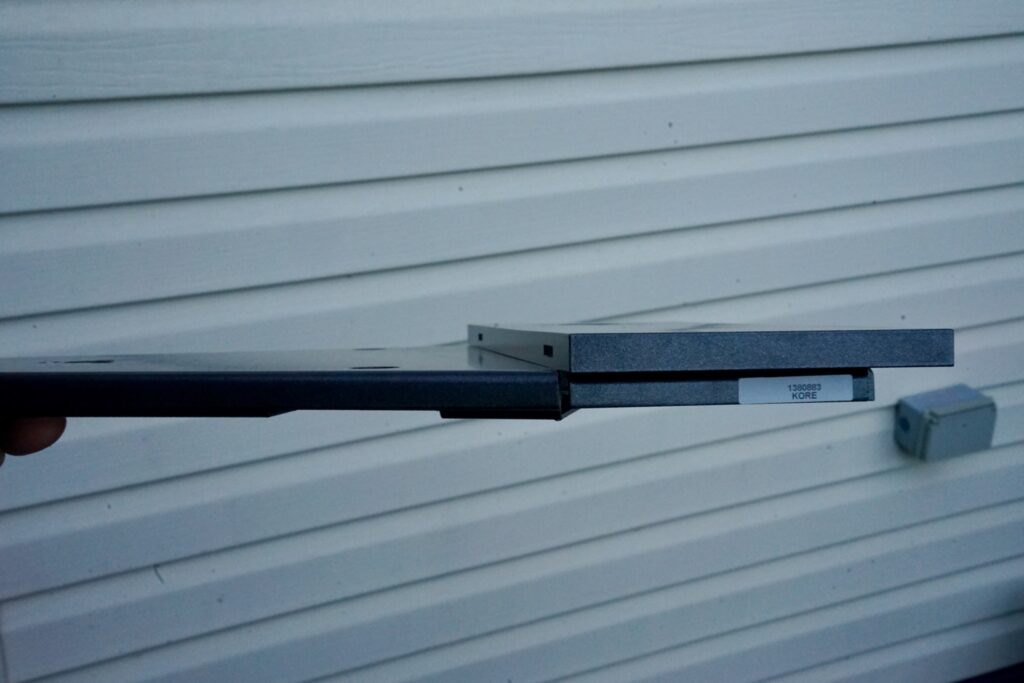
When I took the Kore out of the LP12 this morning, I was able to verify that the armboard isn’t flat: here you can see and hear it knocking against my flat granite countertop. (The Mober that replaced it was totally flat on the same surface.)
I also noticed that when the armboard was as level as possible relative to the plinth, the platter wouldn’t be totally level (it wasn’t out by much, but it was very noticeable with a level). There only seems to be one way to interpret this: the Kore’s armboard is not flat.
The whole point of a one-piece subchassis is to keep the bearing and the tonearm in the same plane. Now that might still be happening here: an out-of-true armboard doesn’t necessarily mean that the bearing and the arm pillar are being held out of true. But it doesn’t give me a lot of confidence that they are. It have serious doubts about whether the Kore is carrying out its “kore” purpose.
In turn, this seems to means that cartridge alignment with the Kore is necessarily going to be off, since the tonearm isn’t tracking the plane of the record. I don’t know how much of an actual audible difference this could make, but it seems like it could make one.
By the way, I’ve inspected my Kore carefully, and there is no evidence to suggest it has ever been dropped or otherwise abused. The sparkly finish is immaculate. How you would bend a machined piece of aluminum without leaving a mark is beyond me. Then again, how a machined piece of aluminum could get a bend in it at all is also beyond me. It should be really strong and very rigid. I got this used and installed it myself, so take this with whatever grains of salt you like. But for me, it’s just more evidence of shoddy workmanship by Linn. As with my noisy-motored Lingo 4, it looks like there is a fundamental problem with my Kore.
Of course, the basic construction of the Kore could also be having a negative effect on sound. Maybe it’s not that’s it’s out of true; maybe it’s that it’s made from multiple pieces of aluminum screwed and glued together, versus the single piece of machined aluminum in the Mober it replaced.
All of the above speculation led me to replace the Kore with another Mober armboard. (I already had a Rega model, which I bought with my own money; Edmund of Mober sent me the Linn-spec’d model to review). That’s the next thing I’ll be listening to.
3. Maybe there’s something wrong with the Ekos
You read a lot about Ekos bearings sticking, or about the internal wiring getting old and inflexible and impeding free movement of the arm. Either could explain bad tracking or poor audio performance. Based on all the tests I’ve been able to conduct, including the famous “swing test,” the bearings seem fine in my Ekos. The movement seems absolutely smooth in both the vertical and horizontal directions, so the internal wiring seems fine, too. But you never know, I might be missing something.
4. Maybe the XX-2 is super-sensitive to motor noise, and my Airpax/Mose Hercules II setup isn’t equal to it.
That could be. Shame my Lingo 4 was such a disaster. Thankfully I have a Mober DC motor kit now and I’ll be installing it shortly. Assuming it works properly, it will allow me to test this idea.
5. Maybe the XX-2 just doesn’t sound that good. Maybe MC cartridges don’t necessarily sound better than MM cartridges.
Just because it’s expensive doesn’t mean it’s good. Just because it’s a moving coil design doesn’t mean it’s better than a moving magnet. I must admit, I absolutely assumed both of those things going into these recent rounds. Maybe I was wrong. Or maybe I just prefer MM carts in general or the Adikt in particular over MC carts and/or the XX-2. Future tests with other cartridges should provide some insight into this.
6. Maybe the Adikt/Nima/Mober combination is just awesome
That would actually be great news, because each of those pieces is pretty affordable. We could all save a lot of money.
Notes on casual listening
I listened to a lot of music with this setup. I had it in place for a full month, really giving it an honest shot to impress me. Most of that time, I was in coronavirus lockdown, so I had plenty of time to listen to records. I did no fewer than nine Best Pressing Shootouts with this setup and listened to many, many, many hours of music as I did actual work.
I wrote a lot of notes about my “casual listening” impressions. At first, I was really happy to note that it sounded much better than the previous XX-2/Nima/Mober combination, and that the dreaded “thud” was gone. I listened to Prince Lasha, Serge Gainsbourg, and New Order a lot during this period, and I was happy.
I did notice some annoying sibilance with Gainsbourg, which is when I double-checked my alignment. But the alignment seemed pretty much fine, so I figured that sibilance must just be in the disc. But I have been noticing more sibilance than usual, I think, so it may be the tracking issue.
Then I wrote a billion more notes — too many to record or even summarize here. Many times, I thought I was hearing a particular track or album sounding better than ever before. But mostly, I wrote that it sounded good but wasn’t wowing me. When it finally came time to sit down and listen to my test tracks, I was pretty sure they would show exactly what they did: that things had improved a lot over the previous round, but weren’t as good as they’d been in Round 5.
Test tracks
All the “regression/improvement” metrics below are in relation to the best-sounding previous setup; in this case, Round 5.
1. The Beach Boys, “I Know There’s an Answer,” Pet Sounds (1966)
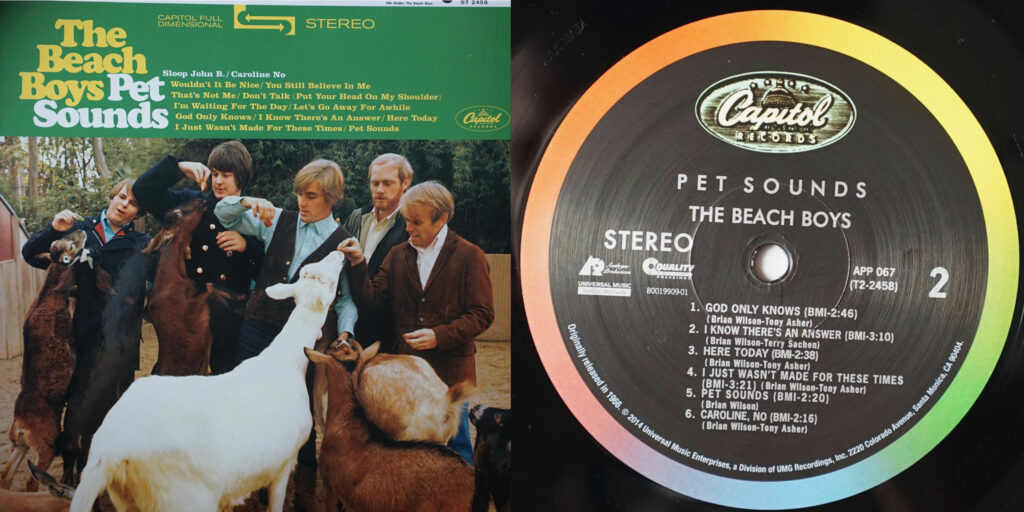
Full digital. Okay, let’s roll! It’s been a while since I’ve done one of these tests, mostly because I really wanted to give myself a chance to get acclimatized to the Ekos/Kore sound before judging it. And I got distracted doing lots of Best Pressing Shootouts, which are fun and take much less time than a round of LP12MFs! Anyway, this is sounding really pleasant; detailed, with good textures, very lively and nice. I’m not blown away or anything, but a few audio thrills here, in the usual places: bass harmonica, shakers, full round bass.
Full vinyl. Hmm, this sounds really good: the bass seems deeper, more visceral. There’s a smoothness to the vocals, a relaxed depth to the bass (instrument and bass drums), as well as lots of space. It’s always possible I’ve just turned the volume up a little higher. But it definitely sounds good, and my sense is quite a bit better… 10-15% range or so…
Slight delay. A bit hollower, harder, on digital, definitely. Lots more bass, way more smoothness on vinyl, along with all the detail. Much smoother, more enjoyable presentation on vinyl. Acoustic bass right before the bass harmonica part is much better defined on vinyl, as is the bass harmonica itself. Probably more like 20% better. It’s like a rattlesnake is singing the song to me on digital. Hollow, sharp, hissy.
Second-to-second. Balanced much more toward bass on vinyl, but definitely in the right way. The shakers sound absolutely terrible on digital: so harsh and chalky. They sound like noise or distortion on digital; they sound like shakers on vinyl. I just had the “gross” physical reaction switching from vinyl to digital in the bass harmonica solo. The body doesn’t lie. Vinyl is giving this track a big, rich, full-throated, full-bodied performance. Really nice.
Verdict: vinyl is 20% better (5% improvement)
2. Charles Mingus, “Track B — Duet Solo Dancers,” The Black Saint and the Sinner Lady (1963)
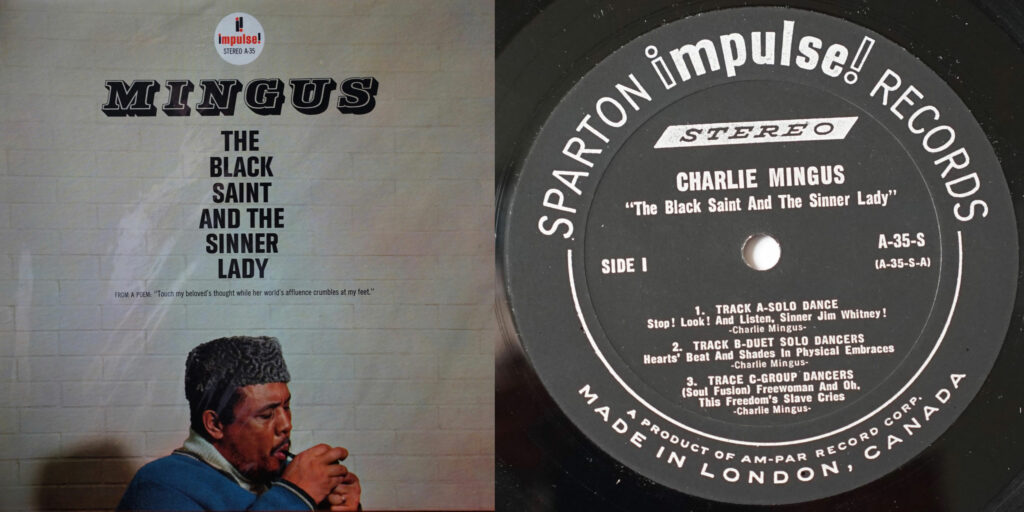
Full digital. My notes from the previous round complains about hard right/left panned instruments and a tinny quality to the cymbals. I can definitely see that. In general, “tinny” might be how the digital setup is sounding in comparison to the vinyl tonight. But the parts I usually like sound as good as always, including the famous “cordy sax” (I wonder if anyone reading this — if anyone does! — has any idea what I’m talking about…)
Full vinyl (just the Sparton tonight — I’ve been doing enough pressing-comparison in the BPS series!). A bit of surface noise, but also a nice warm embrace, like the whole soundstage is wrapping me up in its bear arms. Coherent, non-tizzy, smooth, engaging — I’m loving this. Plenty of impact when called for, but the overall vibe is definitely smooth — it feels less manic, less Freudian than it normally does. The “cordy sax” (finally just selected “Learn spelling” on that word, lest it get autocorrected again to “corny”) is three dimensional, the sonic equivalent of the starship Enterprise traveling through a CGI wormhole. Really, really nice listening. Let’s to some direct comparisons…
Slight delay. Very similar differences to The Beach Boys above: vinyl is smoother, heavier on the bass, much better with cymbals, much more pleasant to listen to. Much, much more texture coming from the deeper reed instruments — and I’m all about texture. Switching from digital to vinyl puts a smile on my face. Things get smoother, better balanced, with better textures, no less detail. On the quiet drum part, too, despite the surface noise, the vinyl gets everything right: more detail, more impact, better texture. It’s a big difference. Maybe not quite 20%, but around 15%. The vinyl system just gets this music way better.
S-2-s. Treble way over-emphasized on digital; just absolutely right on vinyl. So engrossing, inviting, as I said above. Not quite at the “gross” threshold, but definitely 15% better. Definitely want to keep listening to this record! But — the duties of an audio blogger — it’s on to the next track…
Verdict: vinyl is 15% better (10% improvement)
3. The Pentangle, “Let No Man Steal Your Thyme,” The Pentangle (1968)
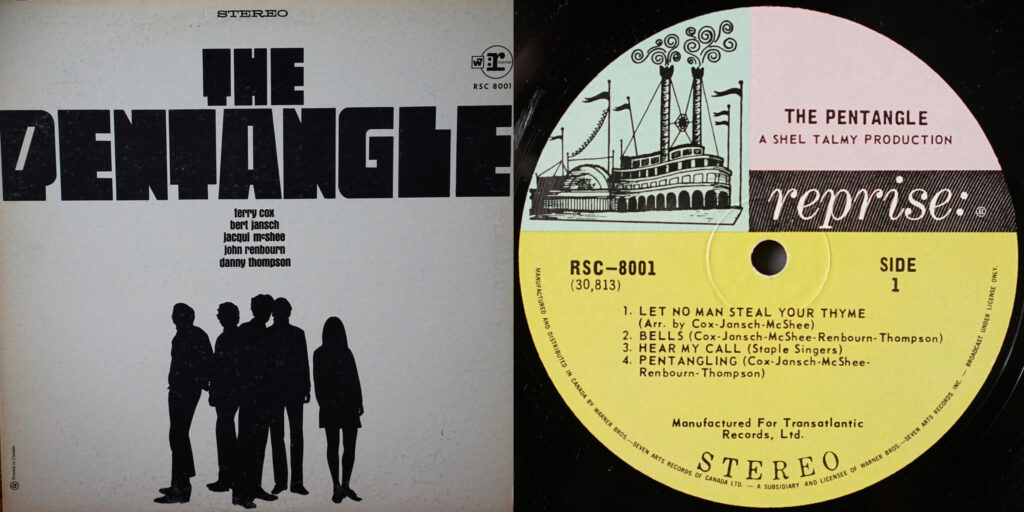
Full Reprise vinyl. I don’t want to get into a multi-pressing listening test, and I think I’m going to jump ship to the Transatlantic from now on since I like listening to it better, but I’m curious how they compare. This sounds very good — especially the detail on the acoustic instruments — but Jacqui’s voice sounds a little muted, distant. Instrumental part is really nicely atmospheric, engaging, immersive… Bowed bass is really nice, big and thick on the right channel after the break. I probably haven’t heard this sound quite as good before…
Full Transatlantic vinyl. Just so good, so full, so totally full of life. It’s like a very, very ripe citrus fruit. Jacqui’s vocals are much more in focus here — just beautiful. This is one of my nicest-sounding records, no doubt. In the instrumental break, the “springiness” of the left-channel acoustic guitar is very much in evidence. As much as I’m enjoying this, though, I realize it probably makes more sense to stick with the Reprise, since I’ve been using it from the start — and since discs that don’t sound MASSIVELY better than digital are more useful for comparison purposes…
Full digital. Pretty boring, flat, tinny after that gorgeous Transatlantic performance. Nothing is really making me prick up my ears and pay attention…
Slight delay (Reprise). More life on vinyl, a bit more clarity on digital, more present vocals. Textures and space, though, definitely better on vinyl. I got distracted actually listening to this very short track here, so will need to remember to make notes on the S-2-s. Feels like 10% or so for vinyl though…
S-2-s. Fuller, better texture on vinyl. I like it much more. The balance is again tilted away from treble and toward bass, but I don’t think you lose any detail at all. Not quite ready to go to 15% here, but 10% definitely.
Verdict: vinyl is 10% better (no improvement)
4. Mariah, “Shinzo No Tobira,” Utakata No Hibi (1983)
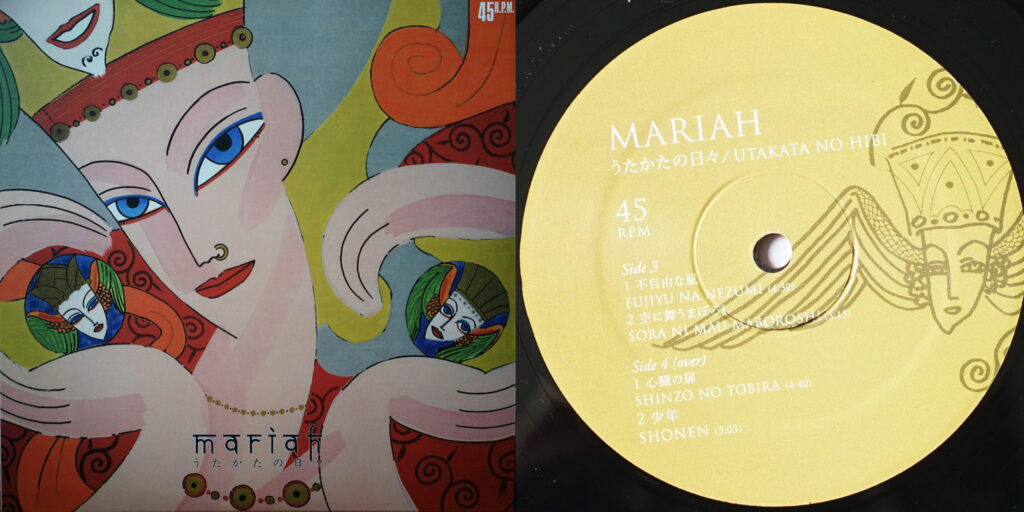
Full vinyl. Okay, listening session #2. Let’s start with the vinyl. Last round, I liked the way the first three sounded, then was grossed out by how these three sounded. Let’s see if the Ekos/Kore (and my setup) has fixed whatever went so horribly wrong last round. Sounds very, very nice from the first notes. The shakers are very crisp, the bass is huge, the vocals are spacious and clear. Drums have tons of texture and kick. Lots of thrills on the analogue synth part. My sense is that my system has definitely recovered from what ailed it.
Full digital. The chalkiness and lack of springiness/juiciness/slam are very apparent after vinyl listening. Which is why it’s better to start with the less-good-sounding track on these full listens. Now I can’t be bothered to finish. Onto the direct comparisons…
Slight delay. Lots less life, slam, sense of space on digital. Again, the balance tilts toward the bass, but in a really nice way: strong, thick, full, but not in any way muting the bright tones of the shakers. Definitely nice textures and balance on the synth breakdown. BUT, I don’t think the differences are quite what they were in the SSP12 round. Maybe 15% better? No, maybe 20% — there is a “gross” element. Just not anything more than that.
S-2-s. No, not “gross” levels, at least not on the rattle introduction. They sound similar, with similar levels of detail — only the vinyl presentation has much more slam, much more powerful and pleasant bass. Once the bass and vocals come in, certain peripheral soundstage details to come into clearer focus on vinyl. Vinyl is better on the synth textures. But the differences aren’t overwhelming. It’s 10-15% level — listening one last time, more like 15% for all the extra kick that the vinyl has.
Verdict: vinyl is 15% better (10% regression)
5. Joy Division, “Atmosphere,” 12″ single (1980)
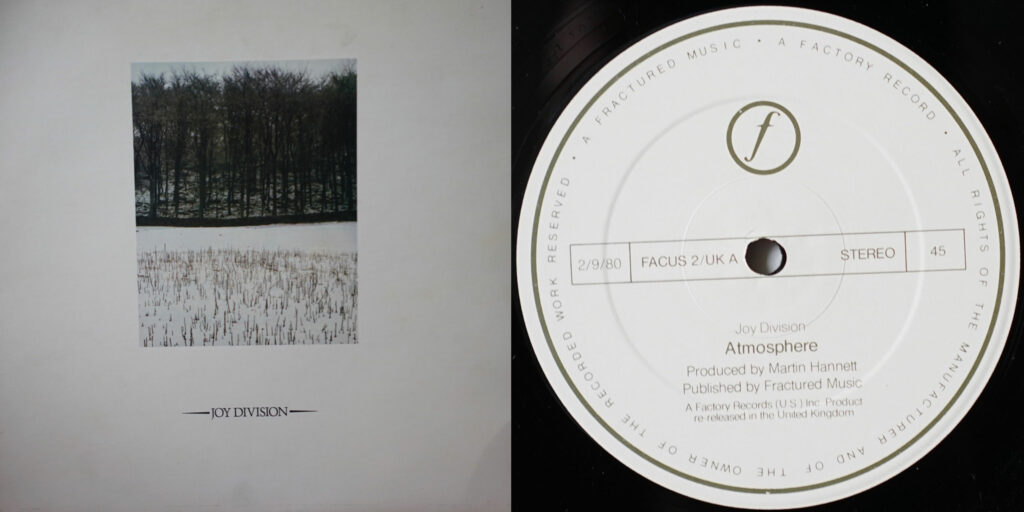
Full digital. Time for the real test! These drums should sound INSANE on vinyl if this new setup is really working. On digital they sound totally fine. But I expect to have my sense of them as good totally shattered when I put on the vinyl…
Full vinyl. I’m not sure it’s there. I’m not freaking out at how this sounds. I bet it’s a bit better than the digital, but I don’t think we’re anywhere near the 30% plateau of the SSP12…
Slight delay. Definite advantage to vinyl — lots more impact and lots more detail — but around the 20% level, I’d think. The more I listen to it, the more I like the vinyl presentation — it’s much, much nicer, more detailed, thicker, stronger. But yeah, no more than 20%, I don’t think. (The vinyl cymbals really put the digital ones to shame.)
S-2-s. Moment-to-moment comparison only makes this stronger. But it’s 20%, not 30%.
Verdict: vinyl is 20% better (10% regression)
6. Low, “Just Make It Stop,” The Invisible Way (2013)
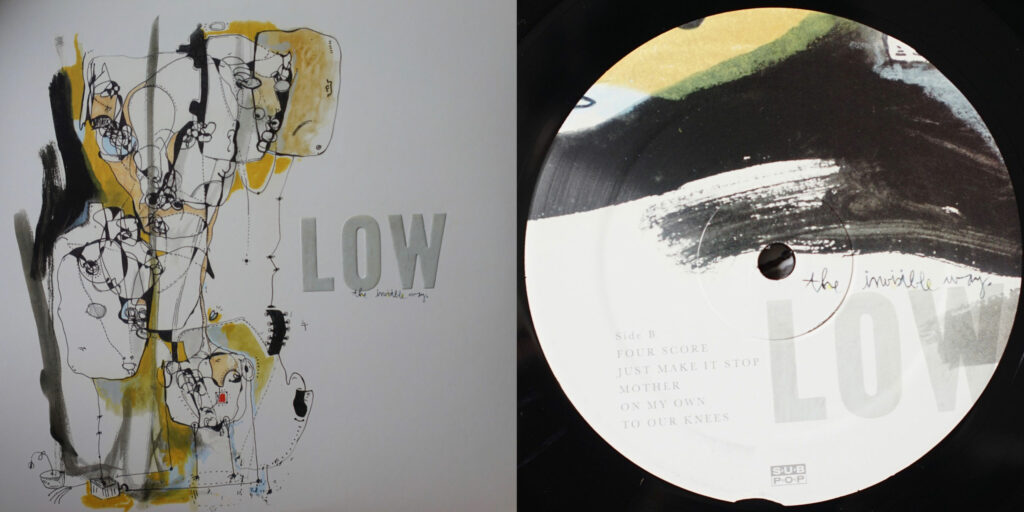
Full digital. As in previous rounds, I am impressed by the sound of this track: rich, atmospheric, gentle and tough at once. I do hear how Mimi’s voice sounds a little constrained at times, though.
Full vinyl. In the SSP12 round, I had a kind of out-of-body transcendent experience listening to this track. I don’t think I’m there this time. It sounds excellent in all the ways the digital does, with some added delicacy on cymbals and a slightly constrained feel to Mimi’s voice. But I’m not having any kind of experience of transport here.
Slight delay. Definitely better on vinyl, definitely not like last round where I could barely tell a difference. But more of a 15% difference, here: clear differences you hear when you look for them, an overall sense of one sounding quite a bit better than the other, but not a shocking, transformative difference between them. Notably, the balance is very similar on both versions this time — the vinyl is not noticeably balanced to the bass.
S-2-s. I do occasionally get the “gross” feeling switching back and forth, but not consistently. The digital sounds shallow, tinny, tizzy in comparison to the big, thick-yet-detailed presentation of the vinyl. But only around 15% overall. It’s not like on the SSP12 round.
Verdict: vinyl is 15% better (15% regression)
7. Yo La Tengo, “Stockholm Syndrome,” I Can Feel the Heart Beating as One (1997)
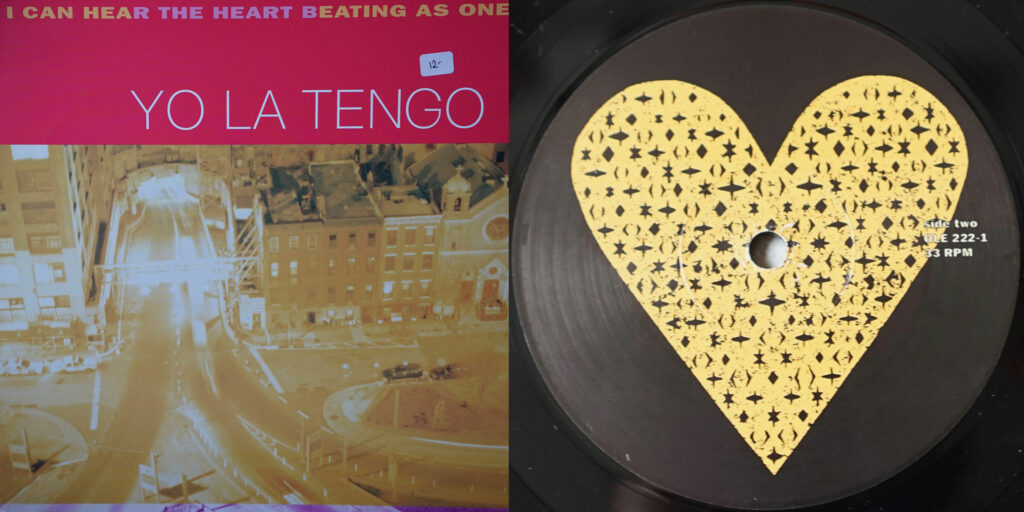
Full vinyl. Okay, onto the third listening session! Going in blind with a vinyl listen. It sounds really nice: lively, rich, with terrific detail on the acoustic guitar. But I have the strong sense that I’ve heard this sounding better before…
Full digital. Clearly worse than vinyl. Flat and distant. From this back-to-back, I’d put this in the region of 15% or so… not the insane 35% difference I heard in the SSP12 round.
Slight delay. Significant difference, but definitely not 35%. I’d put it right on the “gross” threshold. James’s voice, especially, sounds distant, pixellated. There’s a lot more drive and heft on vinyl. But I’m just not getting that WOW factor that I’ve heard so many times before on this track.
S-2-s. The differences are a bit more apparent in second-to-second comparison. Clear “gross” reaction. Vinyl is 20% better — but no more.
Verdict: vinyl is 20% better (15% regression)
8. The Beatles, “While My Guitar Gently Weeps,” The White Album (1968)
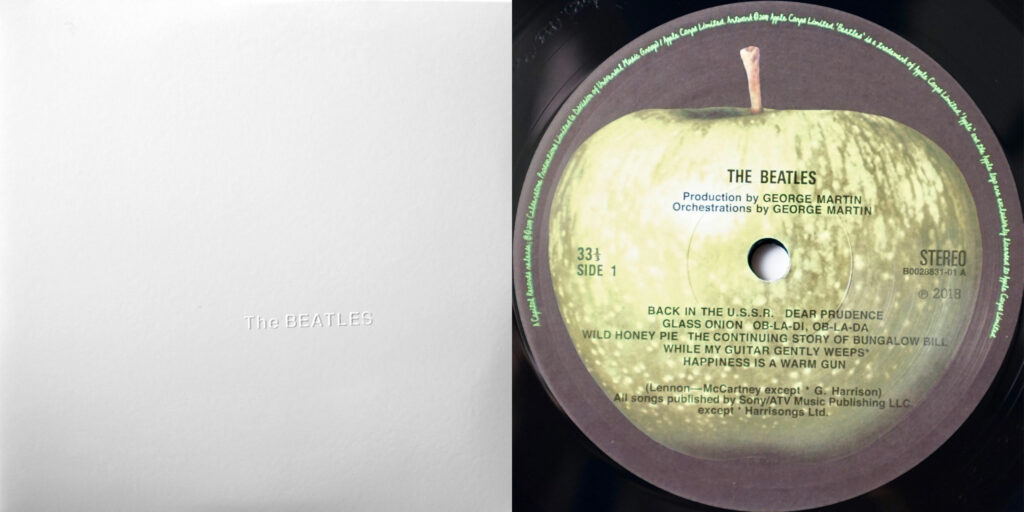
Full digital. This is one where I can immediately pick up on the “digital profile”: it’s too bright, it lacks smoothness, there’s a harsh glare to transients, there’s a lack of lifelike naturalism to acoustic instruments (here, acoustic guitar). The bass is driving, but the effect is undone by the harshness of the treble. Really pretty unpleasant to listen to.
Full vinyl. Definitely way better. Authority in the bass, beautiful detail on the acoustic guitar and on the “clippety clops.” Really, really nice presentation here. Huge, meaty, soaring. After a bunch of “meh” experiences, this is a welcome change. Wow, the bass drum is absolutely clobbering my right ear!
Slight delay. Wow, yes: the tones are all just way off on digital: brittle, hollow, nasty. On vinyl, beautiful, round, detailed. Especially noticeable on the bass, which is the highlight of the song, and the acoustic guitars, which sound absolutely pixel-barfy here. This is at least 25%, maybe more.
S-2-s. This vinyl system nails this song. I don’t think it’s quite at the 30% threshold — and I could use a bit more acoustic guitar at the front — but the driving bass and the bass drums are HUGE here. Digital is hollow, echoey, nasty in comparison. This system definitely “rocks.”
Verdict: vinyl is 25% better (5% regression)
9. Dungen, “Panda,” Ta Det Lugnt (2004)
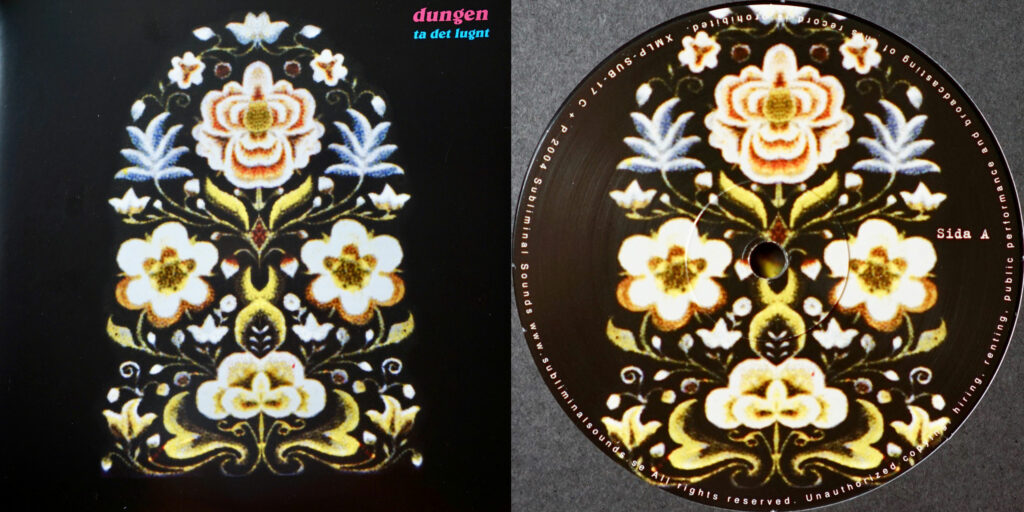
Full digital. Ah, how I love this song, as a song, and as a recording. As always when I listen to the digital first, I’m thinking, Wow, this sounds amazing — how could it sound any better? Well, it certainly has in the past — 30% better in the SSP12 round, according to my notes…
Full vinyl. Yowzer, that’s how! Those drums sound HHUUGGEE here and totally natural. Yeah, this setup really does rock. Lots more drive, power, energy here, I think. I’m making all kinds of nasty rockstar faces here as I listen along.
Slight delay. Absolutely a “gross” experience going back and forth. The drums are so much wider, more three-dimensional, more natural on vinyl — and the power and richness of the track: wow. It sounds incredible. Narrow, full of glare, grey on digital. Yuck. This could be 30%. The audio mushroom cloud at the end sounds absolutely gorgeous. Best track so far this round!
S-2-s. I’m a little mystified as to how this track can sound as good as the SSP12 round when so many of the others sound so much worse… But I’d say this is definitely in the 25%-30% range. The tones are just wrong on digital. They’re totally right and just massive on digital. Listening through the track, though, I’m a little hesitant to call this 30%. More comfortable with 25%. Still, a huge difference, and a really great performance on this track.
Verdict: vinyl is 25% better (5% regression)
10. Julee Cruise, “Rocking Back Inside My Heart,” Floating Into the Night (1989)
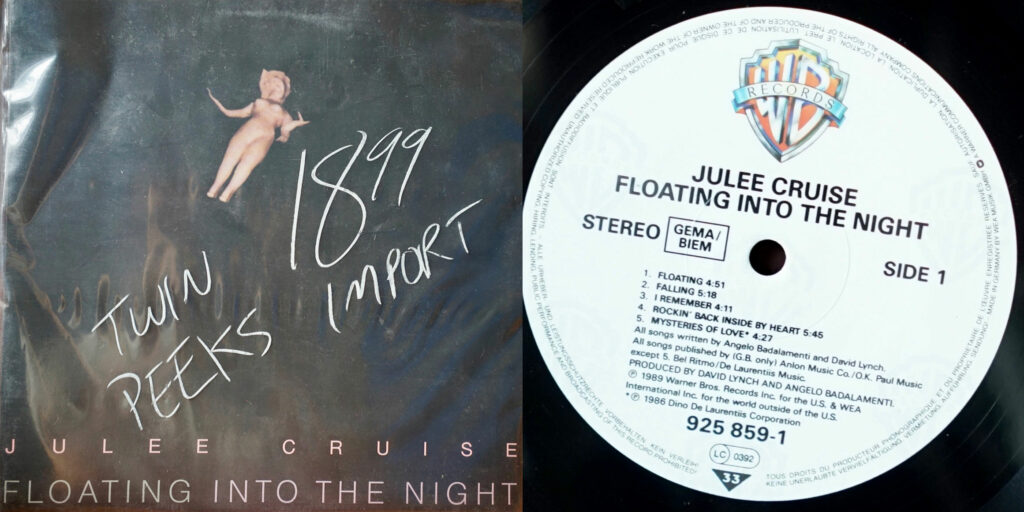
Full digital. Okay, the last listening session begins! I truly love this song, and I’ve always thought it sounded really good on digital. And indeed it does. I know the palm mutes have sounded crisper, but I’m not especially missing them here. The sax blast is cool but not mind-blowing, as I know it can be…
Full vinyl. Definitely better. The magical soundscape is there: open and wide and weird. Lots of weight on the bass, as I’ve come to expect from this setup. The palm mutes aren’t knocking me out, but I think I can hear more detail on them. The sax blast is mind-blowing on this setup! Very nice.
Slight delay. Yes, fuller and with more detail on vinyl. But I’d say more in the 20% range than the 25% of the SSP12 round. The sax blast confirms that it’s definitely a 20% difference. But no more, I don’t think.
S-2-s. The second-to-second comparison confirms the above. Definite advantage in bass, width, fullness, and detail. But 20% only.
Verdict: vinyl is 20% better (5% regression)
11. Can, “Halleluwah,” Tago Mago (1971)
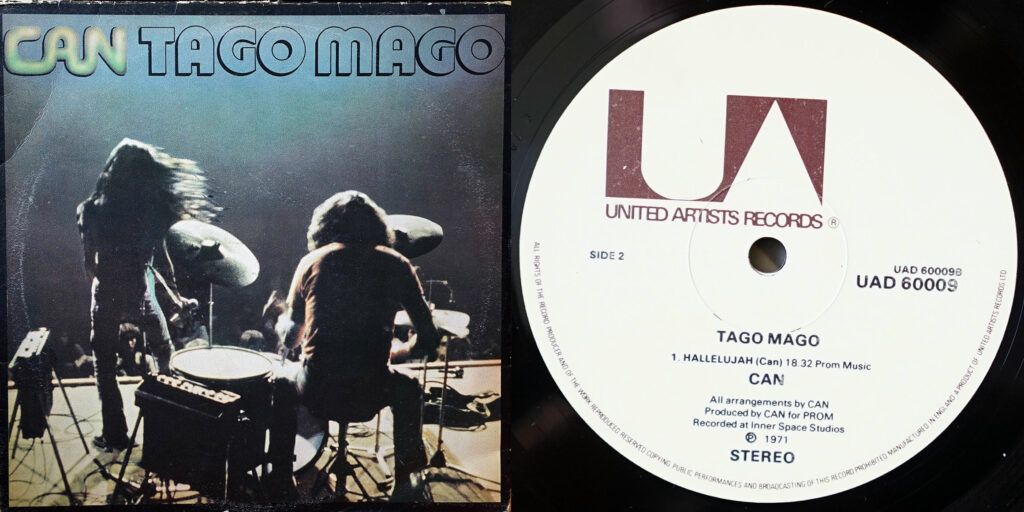
Full vinyl. A little scratchy and distant, a touch hollow, at the start — as it usually is on this pressing. But the drums are lively and dynamic, and when the intense drums kick in about a minute in it sounds huge. Bass performance on this system is definitely impressive. The louder the drum part, the better it sounds. This is definitely up there with the best I’ve heard this song sound.
Full digital. Flatter on digital, chalky, grey. Transients sound harsh and distorted. The intense drums at 1:00 are nothing particularly special. I’d guess about 20% worse than the vinyl.
Slight delay. Vinyl definitely nails this song. So much SLAM! The digital sounds really thin, harsh, hissy. There’s like twice as much bass coming through on vinyl, and it really works for this track. This is definitely a 25% difference for the impact of the drums alone, which is obviously such a huge part of this song. No comparison.
S-2-s. Rather than starting again, I just got them in sync from the quiet part at 5:00. You know, in direct comparison, there is a little bit of treble detail that’s being lost on vinyl. The presentation is nicer on vinyl — much nicer — but some of the more treble-focused instruments come clearer on digital. So let’s say 20%.
Verdict: vinyl is 20% better (5% regression)
12. Bill Callahan, “Javelin Unlanding,” Dream River (2013)
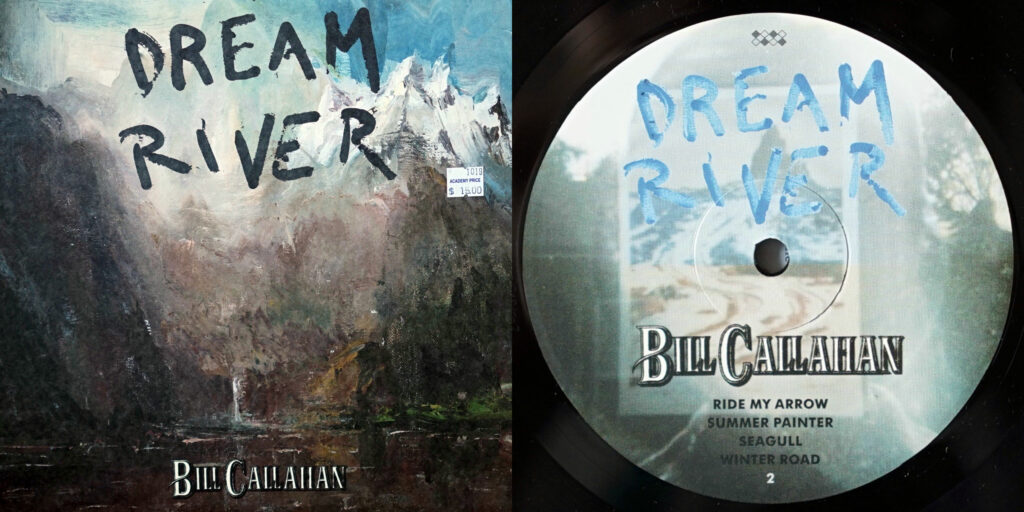
Full digital. Not a good-sounding track on digital. At all. Flat, pixellated, hard. BC’s voice is filtered and distant, and the steel string instrument in the background is very 8-bit chiptune. Not a pleasant listening experience at all.
Full vinyl. More surface noise than I remember? Sounds better but still not good. Some of that chiptune effect might just be in the song. BC’s voice doesn’t sound natural, as I’ve noted it has in previous rounds. But the drums and cymbals sound pretty good and give the track a nice, wide soundstage.
Slight delay. Better on vinyl, maybe 15%. I don’t think this song plays to the vinyl setup’s strengths. This song needs as much clarity and detail as it can get. So while there is more space an detail and more focused, natural tones, it’s certainly not the best I’ve heard it sound.
S-2-s. The vinyl advantage is a little clearer in direct comparison. But I still don’t think we’re in 20% territory: the vinyl doesn’t make the digital sound “gross,” in comparison. (Which it should: this song sounds awful on digital!)
Verdict: vinyl is 20% better (15% regression)
Next steps
As I type out these notes, I’m listening to the next step: I’ve swapped the Kore out for a Linn-cut Mober subchassis. Then comes more Mober fun: I have Edmund’s DC motor kit just waiting to go in. After that, it will be time to play some more with cartridges: another MC cart, the Troika, and then my old reliable MM, the Adikt. Then I’ll try out the Naim Aro tonearm with its Greenstreet chassis. Then I’ll test out the Mober bearing on whatever ends up being my favourite setup. I’ll play around with ultrasonic cleaning a bit more. Then… the LP12MF will be done and I’ll be able to stop listening to these tracks for a bit!!!

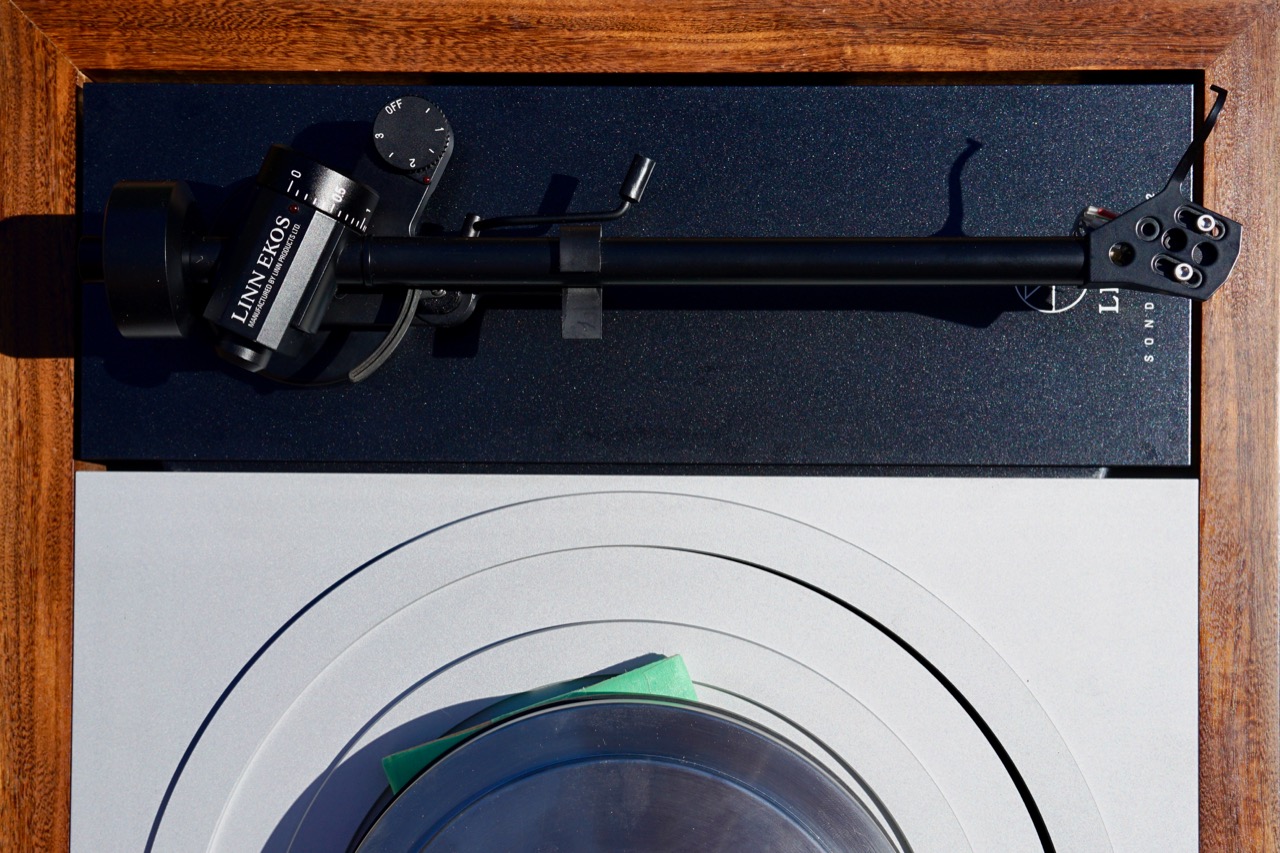
2 Comments
Join the discussion and tell us your opinion.
I was under the impression that the Ekos MkII had the white dot and the Ekos had the red dot… ideas? Currently building yet another LP12 and trying to navigate 2nd hand tonearms.
An archived conversation from the defunct Linn forum, via https://www.lejonklou.com/forum/viewtopic.php?t=4383
EKOS
Cymbiosis (2009-03-26) Wrote:The Ekos 2 started with serial Nos above 6200 so all numbers above are going to be Ekos 2’s. However, with serial Nos below 6200 but claiming to be upgraded to Ekos 2’s, it’s best to ask your dealer.
Upgrade:
What You See and Hear (2012-02-25) Wrote:While the Ekos was in production you could have it “upgraded” to MK 2 spec. This used to cost around £500.00 and the main assembly (Pillar, Gimbal Block, Arm tube and Headshell) was scrapped and replaced with new. This afforded the user greater performance as the replacement item was mechanically stronger. This “MK2” update was phased out as the Ekos Arm production ceased with the introduction of the obviously very different and much more expensive Ekos SE … The reason you could get a new assembly so cheaply was that Linn could scrap the old one but transfer the serial number to the new assembly and it was effectively the same as seen by the taxman.
Identification:
What You See and Hear (2015-05-12) Wrote:It (Silver dot as opposed to Red dot) does “indicate” it’s a MK11 spec arm. However I recall having a deck here once where the tracking weight registration dot was missing and I replaced it with a silver version (also sometimes called white dot). This was only because the red one was no longer available. I don’t recall whether this was a MK1 or MK11 arm but its still out there somewhere.
Beyond that “rogue” sample I would say that generally an arm with the silver dot is either a late Ekos in the 8000-10,000 S/No range or an older MK1 arm that was sent to Linn for upgrade to MK11 spec during the time these late arms were produced.
Linn ran out of the plastic red bead dots at this time and went over to a silver aluminium version.The Ekos was introduced in 1988 starting at about S/No 1100 for some reason and I guess the red dot was changed to silver at around S/No 8000 or later in the early 2000’s. Any arms upgraded to MK11 during this late period would have a silver dot as well right up until the arm was discontinued and replaced by the Ekos SE.
As already stated a slotted pillar indicates a MK 1 whereas a smooth pillar is MK2. But there are a small number of very early MK11 arms with a slotted pillar so nothing is quite so simple as it seems.